The Pantanal of southern Brazil (Brasil) is the world’s largest tropical wetland at from 54,000 to 75,000 square miles. It is a seasonal wetland, experiencing both wet periods and dry periods. My son and I spent 10 days in the area during the dry season. During the dry season thousands of birds concentrate along the streams and ponds which remain. I was there in July 2003.
Links to the individual bird species I recorded in this area are listed on the Brazil portal page (see also The Birds of Brazil video portfolio). A listing of the bird species shown in each of the long form videos is shown below. There are five long-form videos which I made for this area, four deal with birds, one deals with reptiles and mammals.
Photographs from these trips can be found in The Birds of Brazil photo gallery on the www.bobbarnes.us website.
My notes from this trip follow the videos below.
Volume 1 of "Brazil’s Pantanal" includes the following bird species; Greater Rhea, Neotropic Cormorant, Anhinga, Rufescent Tiger-Heron, Cocoi Heron, Great Egret, Snowy Egret, Striated Heron, Capped Heron, Black-crowned Night-Heron, Boat-billed Herron, Bare-faced Ibis, Green Ibis, Plumbeous Ibis, Buff-necked Ibis, Wood Stork, Jabiru, Southern Screamer, Black Vulture, Lesser Yellow-headed Vulture, King Vulture, Grey-headed Kite, Snail Kite, Great Black-Hawk, and Savannah Hawk.
Volume 2 of "Brazil’s Pantanal” includes the following bird species; Black-collared Hawk, Crested Caracara, Yellow-headed Caracara, Laughing Falcon, Chaco Chachalaca, White-headed Piping Guan, Limpkin, Sunbittern, Southern Lapwing, Wattled Jacana, Picazuro Pigeon, Eared Dove, Long-tailed Ground-Dove, Picui Ground-Dove, Ruddy Ground-Dove, Scaly Dove, Grey-fronted Dove, Hyacinth Macaw, Blue-crowned Parakeet, Black-hooded Parakeet, Monk Parakeet, Canary-winged Parakeet, Scaly-headed Parrot, Turquoise-fronted Parrot, Peach-fronted Parrot, Squirrel Cuckoo, Smooth-billed Ani, Guira Cuckoo, Great Potoo, White-vented Violeltear, White-tailed Goldenthroat, Blue-crowned Trogon, Rufous-tailed Jacamar, Black-fronted Nunbird, Toco Toucan, Sayaca Tanager, Palm Tanager, and Saffron Finch.
Volume 3 and 4 of “Brazil’s Pantanal” includes the following species; Ringed Kingfisher, Amazon Kingfisher, Green Kingfisher, American Pygmy Kingfisher, Chestnut-eared Aracari, White Woodpecker, White-fronted Woodpecker, Little Woodpecker, Green-barred Woodpecker, Campos Flicker, Lineated Woodpecker, Narrow-billed Woodcreeper, Red-billed Scythebill, Rufous Hornero, Pale-legged Hornero, Ruddy Spinetail, Rufous-fronted Tailorbird, Rufous Caholote, Great Antshrike, Barred Antshrike, Vermillion Flycatcher, Cattle Tyrant, Short-crested Flycatcher, Rusty-margined Flycatcher, Lesser Kiskadee, Great Kiskadee, Boat-billed Flycatcher, Fork-tailed Flycatcher, Black-capped Becard, Black-tailed Tityra, White-winged Swallow, White-rumped Swallow, Brown-chested Martin, Rufous Caisornis, Purplish Jay, Thrush-like Wren, Donacobius, Rufous-bellied Thrush, Rufous-browned Peppershrike, Crested Oropendola, Yellow-rumped Cacique, Epaulet Oriole, Unicolored Blackbird, Chopi Blackbird, Bay-winged Cowbird, Giant Cowbird, Shiny Cowbird, Silver-beaked Tanager, Red-crested Cardinal, Yellow-billed Cardinal, and Grayish Salator.
There are, of course, many mammal and reptile species in the Pantanal. A few are shown in the video below.
Notes From This Trip
Brazil’s Pantanal is one of the great birding places of the world - how do I know? Because I have a score of stories from the Pantanal.
The Pantanal is the largest seasonally flooded area in the world (168,000 square kilometers in Brazil alone). The road from Cuiaba shoots straight south into the heart of the northern Pantanal. During the wet, this area is covered in water, it comes right up to the edge of the roads, which have been built up from the surrounding area.
It is July, the dry season, and I am horseback riding to what is a small island during the wet. We have meandered through a maze of swamp, sometimes with the water up to our stirrups, the Caiman stay away from the horses - I’m glad that Yacare Caiman like fish. (In the video of mammal and reptile species in the Pantanal, the Yacare Caiman is listed as the Spectacled Caiman.) The horses splash, the sun is warm, hundreds of egrets fly into the sky, we pass a Black-Collared Hawk calling from a tree. Jon and I would like to see a Pygmy Anteater and Marina (Luiz and Marina own Pouso Alegre, a wonderful working ranch-hotel not terribly far from Pocone) is taking us to a reliable spot. Not for us today - no Pygmy Anteater, we have to settled for Giant River Otter just a few feet away.
Marina and Luiz have become fast friends and we thoroughly enjoy our long conversations over dinner, it is the kind of special treat I associate with birding -- birders and people of a natural history bent tend to be very interesting.
There are big birds here, like the Southern Screamer pictured above and the Cocoi Heron below. Other “big birds” include the Jabiru (the huge stork with mammoth nests in the tops of trees), four species of Ibis, and various egrets, herons, macaws, toucans, parrots, and…..
One of the target birds of this trip is the Hyacinth Macaw (photo below) - the largest of the Macaws and, of course, dramatically beautiful. I have spent 22 hours getting to Pouso Alegre from Portland, Oregon in the USA. I have had little sleep on the plane, I am tired and sweaty, I need a shower, I am more than a little rummy. I have to get my stuff in the room -- quick. I have to unpack the cameras and tripods -- quick. I have to ... hurry - there are Hyacinth Macaws all over the place - including a preening pair low in a tree thirty feet away.
A Giant Anteater (notes from late July, 2003)
Jon and I are in Brazil’s Pantanal in July, at Pouso Alegre. It is evening and we will eat shortly. Family is visiting the owners and we join all of them on the veranda.
My son and I sit on the porch with our backs against the rough-hewn posts and sip Guarana.
It is early evening but already dark, it is warm, there are candles on the porch, family members are laughing and talking - a brother-in-law breaks out a ukulele (which is a small guitar of Portuguese origin) and everyone breaks into song - except my son and I, we don’t know Portuguese, much less Brazilian folk songs.
It has been a long and pleasantly hard day, lots of taping, some nice Ibis (like the Buff-necked Ibis to the right), and lots of pretty sights. Now I am tired, a cold drink, warm weather, soft darkness, laughter and song - things are perfect. I am at ease, I am pleased with the world. Very soon Alice the Giant Anteater will show up for her bottle of milk.
The owners of Pouso Alegre rescued Alice in a field when she was just a baby Giant Anteater. They raised her on bottled milk and successfully released her to the wild when she reached adult-hood.
In the evenings, Alice often shows up for a bottle or two of milk. Seems you can raise the kids but weaning them is a different matter. She comes up on the veranda and joins in with the family - she may be an Anteater, but those claws are huge and she isn’t taking any guff from the dog. She drains a bottle of milk in no time at all, a beautiful animal, not quite wild at the moment but certainly wild when she is away from here. There is quite a bit of conjecture about whether Alice is pregnant and if so, will she bring her young to the ranch house at night for bottled milk?
I watch this beautiful animal and sip on cold Guarana. There are two Guaranas to be aware of, the first is a powdered mix that the locals drink in the morning as an energy drink. The other is a soda drink of the same derivation. It is the latter that we drink, out of aluminum cans.
Guarana does not have caffeine and has a quite unique taste, very good, very refreshing and the pick-me-up feels very different from caffeine. We enjoy it so much that I periodically order some - its available more widely all the time, we order from Los Angeles -- the shipping is as expensive as the drink.
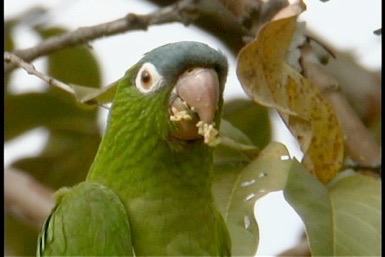
Tomorrow I will tape Blue-crowned Parakeet (right), tonight I could not ask for more.
The Pantanal of Brazil and Paraguay is one of the most magnificent places on Earth. It seasonally floods, flooding everything except the road which has been built up over time. During the dry period the water shrinks to a few swampy areas, ponds, rivers, and the sides of the road - which has been dug out to make the road higher. During the dry the areas beside the road are swarming with birds and caiman.
The road south from Pocone is 117 km and has 87 wooden bridges. There is one concrete bridge. The wood bridges are in varying stages of disrepair and all have holes in them.
Pantanal Bridge
At night the bridges can be really scary, especially if it’s your first time to the Pantanal. Down below there is water and mud - and potentially all sorts of terrible things.
The Pantanal and the bridges of the Pantanal will remain in my memory for as long as I have one -- very fond memories.
A typical view (below) from the road heading south into the Pantanal of Brazil. This photograph was taken during the dry period in July. Caiman are in the foreground, Jabiru, Egret, and Heron species are scattered about. All can be found in the hundreds at sites like this.
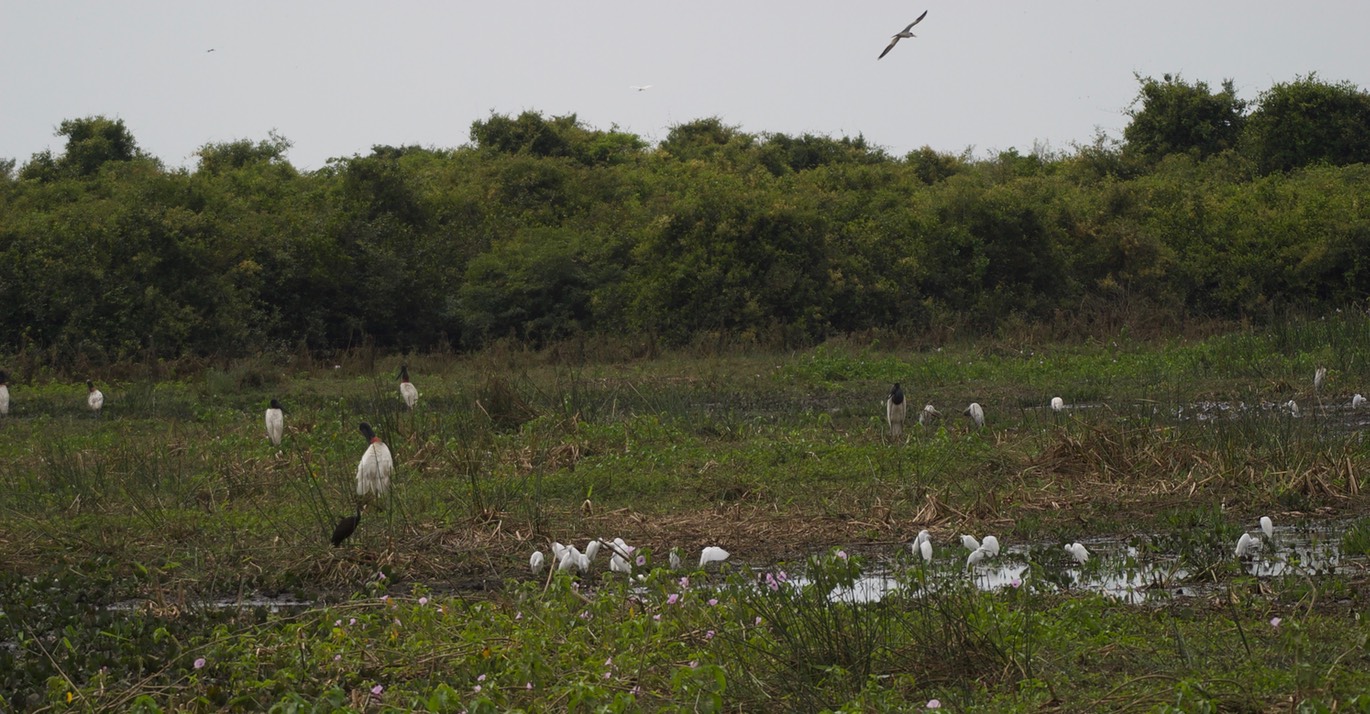
Jon (my son) and I have travelled together to a number of birding locales. I don’t believe that he would consider himself a birder, but he knows the birds quite well, has a good eye, and takes very nice photographs. He photographed Barred Antshrike while we were in the Pantanal of Brazil, not far from where he took the picture of the Smooth-billed Ani shown to the right (he was around 14 at the time).
On the day he took those photographs we were walking down the road in the Pantanal, doing the usual stuff -- videotaping Southern Screamer, Boat-billed Heron, Anhinga -- you know, the usual stuff. He was hanging back, working a bush very hard, I could hear the camera snapping and wondered what it would be. He did not know what it was, he described a Barred Antshrike (or a Lined Antshrike - the differences are not easily described). The bird had flown he said, I looked at the video camera, thought “no video” and forgot about it. While going through the Brazil photos, I found these the images he took and remembered -- and that is the value to me, remembering a hot morning, on a dusty road, working hard with my son - I never want to forget that.
There are a great many things which help to make good video. Good equipment helps. Good light always helps and for video that can be problematic. Early morning and early evening have great light but the window of opportunity is even more limited for video than for photography. Many a morning I have stood beside the tripod watching wonderful birds through my bin’s -- waiting for the light to get better.
Working in the jungle can be frustrating because it is often slow, birds can be hard to find, and when you do find them it is hard to get the camera on them (the ground is uneven, perhaps slippery, vines and leaves are everywhere, it is difficult to get a reference point to figure out where you have the lens pointed, much less where you need to get it pointed).
In the wide open spaces, it can be much easier to tape - if you can find the birds. The light is more even, there are more reference points, and in a place like the Pantanal there are lots of birds. Exotic birds like the Southern Screamer pictured above. That bird was perched on the top of some shrubs (screaming up a storm) eating leaves -- just thirty feet from the road -- in decent light. It does not get any easier than that.
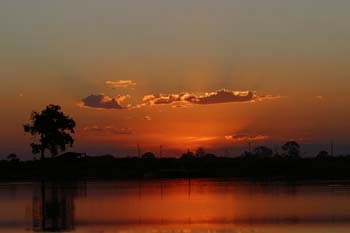
During the day the Pantanal is awash in green and various water colors, as the sun sets the reds and oranges come out -- some beautiful sunsets. That is not to say that the days lack reds and yellows and...no, far from that. When the trees are in bloom the daytime matches the evening.
I mentioned my first encounter with Hyacinth Macaws earlier. A dramatic and adrenaline producing event - in a birding sort of way.
A few days later I was farther south in the Pantanal. It was late afternoon and I was on my way to a “Macaw Tree”. “What makes it a Macaw Tree?” I ask, and the driver smiles, waves his hands (both of them) and says “many Macaws”. Okay, I think - I am nearing the end of this trip and I am run down, to many days of dawn to dusk taping of birds followed by evenings of notes - “many Macaws”, I wonder what that means. I ask, he says 30 or so, I ask again -- not sure my Portuguese is up to the translation my head has provided. He repeats the number, I nod, I am suspect (much easier to be suspect when you are tired and you haven’t seen anything of the sort in days).
We stop by a gate and start walking across a field, we herd the cattle (big mean looking cattle) out of the way as we head into a lightly wooded area. We walk to a tree, we stop. “This is the tree?” I ask. “Yes” is the answer. It is about five, the sun will set in an hour or so, there is little activity. A Savannah Hawk perches on a tree near by and I spend some time with it -- but no Macaws.
Then, like so often is the case, a flock of thirty or so Hyacinth Macaws fly in and perch in “the tree”. We tape until it is to dark, walk back through the field, and head back to dinner. I am smiling a lot, I like it when I am wrong in this way.
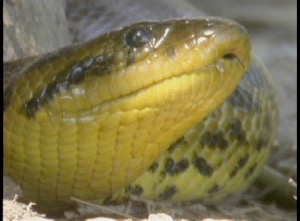
In my journeys in the tropics I very seldom see snakes, perhaps I am simply not attuned to their presence. Snakes, spiders, scorpions, and Jaguars are the big things which people often ask about. But it is the small things which I worry about, mosquitoes, fleas, and other small vectors of disease and parasites. Those are the things which are nasty -- must be why I have so few pictures of them.
One of the most spectacular snakes I have seen is the Yellow Anaconda pictured above from our first lodging in the Pantanal. It was a big snake, we stood around and shot photos and video of this individual for quite some time. It did not seem to be very disturbed by our presence. Anacondas can be nasty though -- their bite is usually a reason to go to the hospital (so if one tries to squeeze the air out of you, try not to get bit). The reason -- infection, they cause very bad infections, in a land where infections can be easily had.
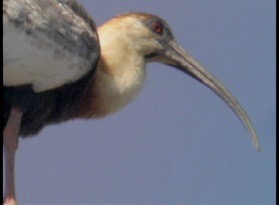
What does a Buff-necked Ibis (photo right) have to do with tea, coffee, and Sanka? In the western US we have one species of Ibis, the White-faced Ibis, I love to visit Malheur National Wildlife Refuge (Oregon, USA) in season and watch them fly about the marshes, with their legs dangling down. Malheur is about 300 miles from my home. It is a special trip.
In the Pantanal of Brazil, there can be four species of Ibis within view at any time (Buff-necked, Barefaced, Plumbeous, and Green -- and only the Green is even a little difficult to find). What is it that I have to give up for such an experience, well for one thing - good coffee. When I first started traveling in Latin America I thought I would have great coffee, that is where the beans are grown, so.... Not the case, they exported all of the good beans and “coffee” in South America typically meant Sanka, old Sanka. South America is where I developed my taste for tea, tea was readily available and it was often very good stuff from the Commonwealth countries. Now that is beginning to change, and coffee is more readily available, but I always check the tea selection first -- because they have some good tea in South America (it goes with the Ibis).
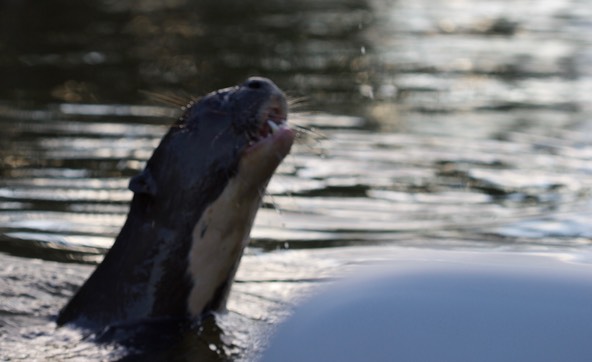
The Pantanal was not all about birds and tea. One night we all climbed into the back of a pickup, standing behind the cab the cool air felt good blowing against our tired bodies as we drove off. We slowly made our way down the track to the main road then onto another track which led to another part of the ranch. A spotlight appeared and we tried our luck at mammals. Jon spotted the first Ocelot and all of a sudden none of us were as tired as we had been. We bounced along the road for a few hours and found a Brazilian Tapir and a second Ocelot (right).
I recently watched a program from the series “Equator” which included some substantial footage of Giant River Otter, or as they indicated - the Water Wolf.
I have seen Giant River Otter on several occasions and each time I am reminded of the disparity between the common image of playful otters and the size of their teeth. Nature is nature, we should never confuse the beauty of nature with any concept of peacefulness. Nature is a continuous process in which creatures and plants take from others in order to survive. We sometimes glamorize rather effective killers as cuddly little play things - but they are not cuddly to their prey. However, that knowledge should never detract from our understanding of their beauty and of how they fit within Earth’s community. A creature's place in the Earth’s community is more impressive to me than its beauty. For that reason, it is important to save ecosystems in their entirety - absent that, the puzzle will fall apart.